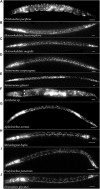Unexpected Variation in Neuroanatomy among Diverse Nematode Species
- PMID: 26778973
- PMCID: PMC4700257
- DOI: 10.3389/fnana.2015.00162
Unexpected Variation in Neuroanatomy among Diverse Nematode Species
Erratum in
-
Corrigendum: Unexpected Variation in Neuroanatomy among Diverse Nematode Species.Front Neuroanat. 2016 May 3;10:52. doi: 10.3389/fnana.2016.00052. eCollection 2016. Front Neuroanat. 2016. PMID: 27199683 Free PMC article.
Abstract
Nematodes are considered excellent models for understanding fundamental aspects of neuron function. However, nematodes are less frequently used as models for examining the evolution of nervous systems. While the habitats and behaviors of nematodes are diverse, the neuroanatomy of nematodes is often considered highly conserved. A small number of nematode species greatly influences our understanding of nematode neurobiology. The free-living species Caenorhabditis elegans and, to a lesser extent, the mammalian gastrointestinal parasite Ascaris suum are, historically, the primary sources of knowledge regarding nematode neurobiology. Despite differences in size and habitat, C. elegans and A. suum share a surprisingly similar neuroanatomy. Here, we examined species across several clades in the phylum Nematoda and show that there is a surprising degree of neuroanatomical variation both within and among nematode clades when compared to C. elegans and Ascaris. We found variation in the numbers of neurons in the ventral nerve cord and dye-filling pattern of sensory neurons. For example, we found that Pristionchus pacificus, a bacterial feeding species used for comparative developmental research had 20% fewer ventral cord neurons compared to C. elegans. Steinernema carpocapsae, an insect-parasitic nematode capable of jumping behavior, had 40% more ventral cord neurons than C. elegans. Interestingly, the non-jumping congeneric nematode, S. glaseri showed an identical number of ventral cord neurons as S. carpocapsae. There was also variability in the timing of neurodevelopment of the ventral cord with two of five species that hatch as second-stage juveniles showing delayed neurodevelopment. We also found unexpected variation in the dye-filling of sensory neurons among examined species. Again, sensory neuron dye-filling pattern did not strictly correlate with phylogeny. Our results demonstrate that variation in nematode neuroanatomy is more prevalent than previously assumed and recommend this diverse phylum for future "evo-devo-neuro" studies.
Keywords: Heterodera; Heterorhabditis; Meloidogyne; Pratylenchus; amphid; heterochrony; invertebrate; phasmid.
Figures





Similar articles
-
Evolution of a polymodal sensory response network.BMC Biol. 2008 Dec 15;6:52. doi: 10.1186/1741-7007-6-52. BMC Biol. 2008. PMID: 19077305 Free PMC article.
-
Postembryonic Ventral Nerve Cord Development and Gonad Migration in Steinernema carpocapsae.J Nematol. 2018 May 31;50(1):27-32. doi: 10.21307/jofnem-2018-005. J Nematol. 2018. PMID: 30335909 Free PMC article.
-
Corrigendum: Unexpected Variation in Neuroanatomy among Diverse Nematode Species.Front Neuroanat. 2016 May 3;10:52. doi: 10.3389/fnana.2016.00052. eCollection 2016. Front Neuroanat. 2016. PMID: 27199683 Free PMC article.
-
The use of Caenorhabditis elegans in parasitic nematode research.Parasitology. 2004;128 Suppl 1:S49-70. doi: 10.1017/S003118200400647X. Parasitology. 2004. PMID: 16454899 Review.
-
Vitamin B12 and predatory behavior in nematodes.Vitam Horm. 2022;119:471-489. doi: 10.1016/bs.vh.2022.01.006. Epub 2022 Feb 25. Vitam Horm. 2022. PMID: 35337632 Review.
Cited by
-
Phenotypic plasticity and remodeling in the stress-induced Caenorhabditis elegans dauer.Wiley Interdiscip Rev Dev Biol. 2017 Sep;6(5):10.1002/wdev.278. doi: 10.1002/wdev.278. Epub 2017 May 24. Wiley Interdiscip Rev Dev Biol. 2017. PMID: 28544390 Free PMC article. Review.
-
FMRFamide-like peptides expand the behavioral repertoire of a densely connected nervous system.Proc Natl Acad Sci U S A. 2017 Dec 12;114(50):E10726-E10735. doi: 10.1073/pnas.1710374114. Epub 2017 Nov 22. Proc Natl Acad Sci U S A. 2017. PMID: 29167374 Free PMC article.
-
The neural basis of heat seeking in a human-infective parasitic worm.Curr Biol. 2022 May 23;32(10):2206-2221.e6. doi: 10.1016/j.cub.2022.04.010. Epub 2022 Apr 27. Curr Biol. 2022. PMID: 35483361 Free PMC article.
-
Immobility in the sedentary plant-parasitic nematode H. glycines is associated with remodeling of neuromuscular tissue.PLoS Pathog. 2018 Aug 16;14(8):e1007198. doi: 10.1371/journal.ppat.1007198. eCollection 2018 Aug. PLoS Pathog. 2018. PMID: 30114260 Free PMC article.
-
Evolution of neuronal anatomy and circuitry in two highly divergent nematode species.Elife. 2019 Sep 17;8:e47155. doi: 10.7554/eLife.47155. Elife. 2019. PMID: 31526477 Free PMC article.
References
-
- Alberch P., Gould S. J., Oster G. F., Wake D. B. (1979). Size and shape in ontogeny and phylogeny. Paleobiology 5 296–317.
-
- Ambros V. (1988). “Genetic basis for heterochronic variation,” in Anonymous Heterochrony in Evolution ed. McKinney M. L. (New York, NY: Springer; ) 269–285.
Grants and funding
LinkOut - more resources
Full Text Sources
Other Literature Sources
Miscellaneous

